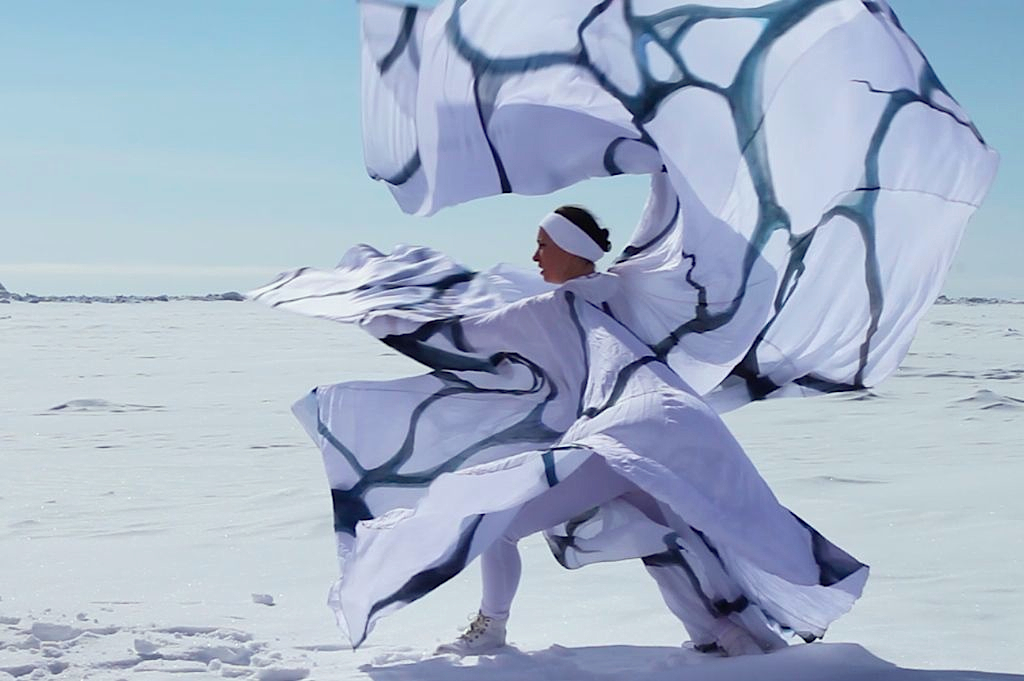New York dancer and choreographer Jody Sperling had a rare opportunity last year. She was an artist-in-residence aboard the Coast Guard Cutter Healy while it was on a research mission in the Arctic. On vast ice floes, she danced while no one watched.
Before she left New York, Sperling was worried about traction.
“And I had in my head that it would be like an ice skating rink, like slick,” she said. “So I got boots that had a real tread on them but they weren’t very high. But what I discovered the first time I went out is that the snow is kind of deep. The snow went right over, into my feet!”
Sperling made do. Twelve times during the six-week mission, she descended the Healy’s gangplank, and joined the teams of scientists on the ice.
“And while they were doing their research in a particular area,” she said. “I would have an area that was dedicated for dance, and I could do my research.”
She wore a Lycra body suit, and those low-top boots. Sometimes she wore a costume made of yards and yards of white silk, printed with a design suggesting ice floes. In videos she shot of herself during the voyage, you can see Sperling twirling and fluttering on the biggest, barest stage she’ll ever find. Last month, though, she was at the Smithsonian Museum of Natural History on a more traditional stage.
With five dancers on deck at the Baird Auditorium, she worked on the lighting the afternoon before a performance. It was part of an Arctic festival the museum hosted.
“It can go from this more icy look to a more watery look,” she told her lighting technician as they searched for just the right blue.
 On stage, some of the dancers wore extra long silk capes, using sticks to control the distant reaches, like an extension of their wing span. Sperling says it’s the silk that’s her medium. She projects light and video on it. It’s a style she’s used before to depict natural phenomena. A scientist at MIT was drawn to a piece she did about turbulence a few years ago. They stayed in touch, and he later introduced her to another scientist who was selecting people for the Healy voyage to the Arctic. The main scientific mission was to follow up on the discovery of a massive under-ice plankton bloom. They also wanted artists for public outreach about climate science. Sperling says she was already interested in the Arctic and climate change, but the offer caught her off-guard.
On stage, some of the dancers wore extra long silk capes, using sticks to control the distant reaches, like an extension of their wing span. Sperling says it’s the silk that’s her medium. She projects light and video on it. It’s a style she’s used before to depict natural phenomena. A scientist at MIT was drawn to a piece she did about turbulence a few years ago. They stayed in touch, and he later introduced her to another scientist who was selecting people for the Healy voyage to the Arctic. The main scientific mission was to follow up on the discovery of a massive under-ice plankton bloom. They also wanted artists for public outreach about climate science. Sperling says she was already interested in the Arctic and climate change, but the offer caught her off-guard.
“When he first invited me – it was 43-day mission in the Arctic, and at that time my daughter was 2 and half,” Sperling said. “And I literally turned white, as white as snow, when he told me because I had these two conflicting urges: ‘I have to go, I want to go, I want to go.’ And the other one was ‘I can’t. I can’t be away for that long.’”
She declined at first – then reconsidered. So in May of last year, she flew to Dutch Harbor, caught the Healy and sailed to the Chukchi Sea, off Alaska’s northwest coast.
“Sometimes we had to break ice and it would be the most amazing sound when you’d be in the ship and you’d be going through the ice and you’d hear grhrhrhrhrh, you know, cracking through the ice. I love that,” she said.
After her Arctic experience, Sperling knew she wanted the sounds of sea ice for the performance. That led her to Matthew Burtner, a musician who considers snow and ice his instrument. Sperling quickly figured out she didn’t just want to buy a few of his recordings. She was hesitant to ask him, but Burtner says when you play a rare instrument, gigs don’t come along often.

“So if you make music out of ice and snow and someone call you up and says ‘I want to do a piece about ice and snow, would you be interested in collaborating?’” Burtner said. “Well yeah, of course! This is the best!”
Burtner spent part of his childhood in Nuiqsut, where his parents were teachers. He lives in Virginia now, and returns to Alaska annually to collect ice audio.
For Sperling’s project, Burtner says his composition uses data tracking the change in the Arctic ice extent over 16 years. He plays that as a 16-beat sequence, over real-time ice sounds. Burtner says listeners don’t necessarily know what they’re hearing.
“The idea is it should work as music but it has this other kind of secret game hidden inside it,” he said. “And if you discover it, than it works on another level, as well.”
Sperling, whose company is called Time Lapse Dance, also compresses time, to show what’s normally too slow to see. She says the warming climate is in effect doing the same thing, because as ice thins it becomes more dynamic, speeding up change across the Arctic. Burtner says that change defines our era, and his art.
“Like I think our lifetime is the time of ice melting. That we are in the time of ice melting,” he said. “Maybe when I was born there was lots of ice, and maybe when I die there won’t be any ice. That somehow, it’s like a life work.”
The Smithsonian show was a bit of a preview. The full program, called “Bringing the Arctic Home” premieres in New York this month.
